Nissan Maxima Service and Repair Manual: Brake tube and hose
Hydraulic Circuit
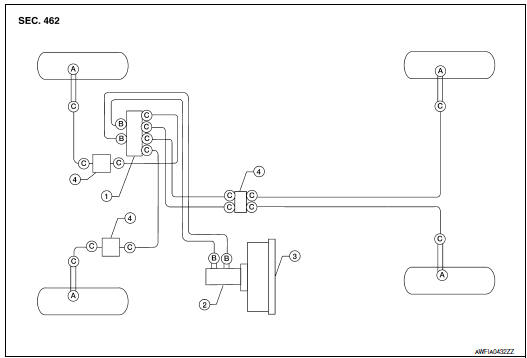
- Actuator
- Master cylinder
- Brake booster
- Connector A. Union bolt
18.2 N*m (1.9 kg-m, 13 ft-lb)
B. Flare nut M12 22.1 N*m (2.3 kg-m, 16 ft-lb)
C. Flare nut M10 16.2 N*m (1.7 kg-m, 12 ft-lb)
CAUTION:
- All hoses and piping (tubes) must be free from excessive bending, twisting and pulling.
- Make sure there is no interference with other parts when turning the steering wheel both clockwise and counterclockwise.
- The brake piping is an important safety part. If a brake fluid leak is detected, always disassemble the parts. Replace applicable part with a new one, if necessary.
- Be careful not to splash brake fluid on painted areas; it may cause paint damage. If brake fluid is splashed on painted areas, wash it away with water immediately.
- Do not bend or twist brake hose sharply, or strongly pull it.
- When removing components, cover connections so that no dirt, dust, or other foreign matter gets in.
- Refill with new specified brake fluid. Refer to MA-15, "FOR USA
AND CANADA : Fluids and Lubricants"
(for United States and Canada) or MA-15, "FOR USA AND CANADA : Fluids and
Lubricants"
(for Mexico).
- Do not reuse drained brake fluid.
Removal and Installation of Front Brake Piping and Brake Hose
NOTE: When removing components such as hoses, tubes/lines, etc., cap or plug openings to prevent fluid from spilling.
REMOVAL
- Remove the front wheel and tire using power tool. Refer to WT-60, "Adjustment".
- Remove the reservoir cap.
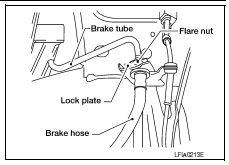
- Disconnect brake hose from brake tube, using a suitable tool.
- Remove lock plate and then remove brake hose from bracket.
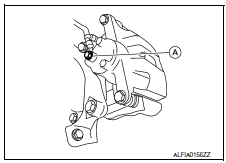
- Remove union bolt (A) and then remove brake hose and copper sealing washers from brake caliper assembly.
CAUTION: Do not reuse copper sealing washers.
INSTALLATION
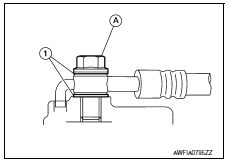
- Install brake hose by aligning with the protrusion on brake
caliper
assembly, then install the union bolt (A) and new copper
sealing washers (1) and tighten union bolt (A) to specification.
Refer to BR-20, "Hydraulic Circuit".
CAUTION: Do not reuse copper sealing washers.
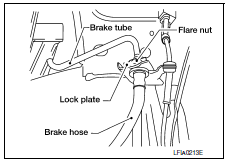
- Connect brake hose to brake tube, partially tighten flare nut by hand as much as possible, then secure it to the bracket with lock plate.
- Tighten flare nut to the specified torque, using a suitable tool.
Refer to BR-20, "Hydraulic Circuit".
- Refill brake fluid and bleed air. Refer to BR-16, "Bleeding Brake System".
- Install the reservoir cap.
- Install the front wheel and tire. Refer to WT-60, "Adjustment".
Removal and Installation of Rear Brake Piping and Brake Hose
NOTE: When removing components such as hoses, tubes/lines, etc., cap or plug openings to prevent fluid from spilling.
REMOVAL
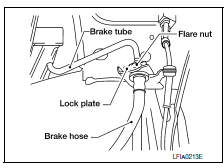
- Remove the rear wheel and tire using power tool. Refer to WT-60, "Adjustment".
- Remove the reservoir cap.
- Disconnect brake hose from brake tube, using a suitable tool.
- Remove lock plate and then remove brake hose from bracket
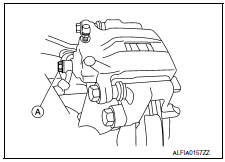
- Remove union bolt (A), and then remove brake hose and copper sealing washers from brake caliper assembly.
CAUTION: Do not reuse copper sealing washers.
INSTALLATION
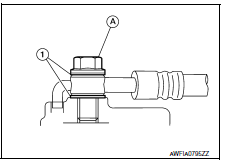
- Install brake hose by aligning with the protrusion on brake
caliper
assembly, then install the union bolt (A) and new copper
sealing washers (1) and tighten union bolt (A) to specification.
Refer to BR-20, "Hydraulic Circuit".
CAUTION: Do not reuse copper sealing washers.
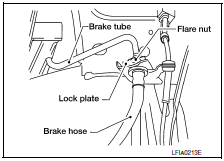
- Connect brake hose to brake tube, partially tighten flare nut by hand as much as possible, then secure it to the bracket with lock plate.
- Tighten flare nut to the specified torque, using a suitable tool.
Refer to BR-20, "Hydraulic Circuit".
- Refill brake fluid and bleed air. Refer to BR-16, "Bleeding Brake System".
- Install the reservoir cap.
- Install the rear wheel and tire. Refer to WT-60, "Adjustment".
Inspection After Installation
Brake tubes and hoses are important safety parts. Always disassemble the parts and retighten their fittings if a brake fluid leak is detected. Replace applicable part with a new one, if a damaged part is detected.
- Check brake lines (tubes and hoses), and connections for fluid leaks, damage, twist, deformation, contact with other parts, and loose connections. Replace any parts as necessary. Refer to BR-20, "Hydraulic Circuit".
- While depressing brake pedal under a force of 785 N (80 kg, 177 lb) with engine running for approximately 5 seconds, check each part for fluid leaks.
 Brake pedal
Brake pedal
Exploded View
Clevis pin
Snap pin
Stop lamp switch
ASCD cancel switch
Clip
Brake pedal assembly
Brake pedal pad
NOTE:
The clevis pin must be installed from the RH side as ...
 Brake master cylinder
Brake master cylinder
Exploded View
Reservoir cap
Oil strainer (blue)
Master cylinder assembly
Brake fluid level switch harness connector
O-ring
PBC (Poly Butyl Cuprysil) grease or
silicone-ba ...
Other materials:
Optical sensor
Description
The optical sensor converts the outside brightness (lux) to voltage and
transmits the optical sensor signal to the BCM.
Component Function Check
1.CHECK OPTICAL SENSOR SIGNAL BY CONSULT
CONSULT
Turn the ignition switch ON.
Select "OPTICAL SENSOR" of BCM (HEAD LAMP) DATA MONIT ...
NISSAN Intelligent Key
WARNING
Radio waves could adversely affect
electric medical equipment. Those who
use a pacemaker should contact the
electric medical equipment manufacturer
for the possible influences before
use.
The Intelligent Key transmits radio
waves when the buttons are pressed.
The FAA ad ...
Sliding sensor
Description
The sliding sensor is installed to the seat frame.
The pulse signal is input to the driver seat control unit when sliding
is performed.
The driver seat control unit counts the pulse and calculates the sliding
amount of the seat.
Component Function Check
1. CHECK FUNCTIO ...
Nissan Maxima Owners Manual
- Illustrated table of contents
- Safety-Seats, seat belts and supplemental restraint system
- Instruments and controls
- Pre-driving checks and adjustments
- Monitor, climate, audio, phone and voice recognition systems
- Starting and driving
- In case of emergency
- Appearance and care
- Do-it-yourself
- Maintenance and schedules
- Technical and consumer information
Nissan Maxima Service and Repair Manual
0.0057
